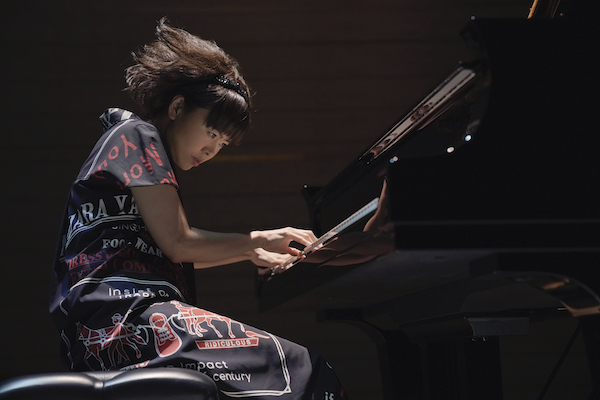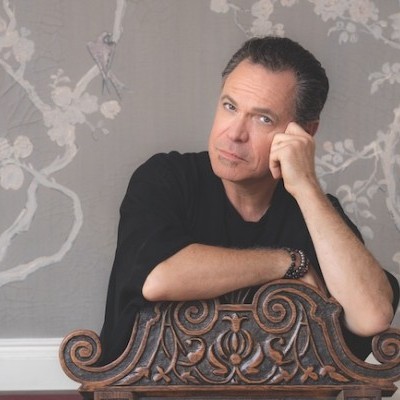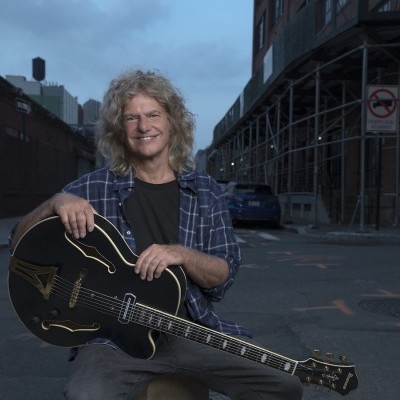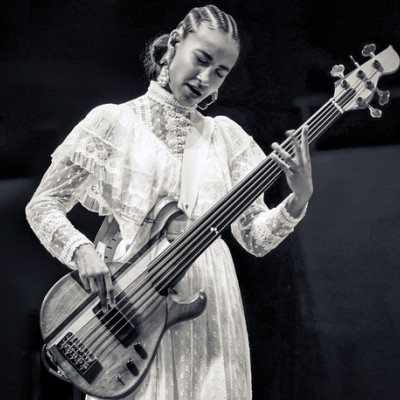Oct 28, 2025 10:47 AM
In Memoriam: Jack DeJohnette, 1942–2025
Jack DeJohnette, a bold and resourceful drummer and NEA Jazz Master who forged a unique vocabulary on the kit over his…

Hiromi’s diverse discography includes collaborations with pianist Chick Corea and harpist Edmar Castaneda.
(Photo: Makoto Hirose)“I was just happy to play,” she said. “It was such a beautiful studio. It made me feel 10 times better a pianist than I am. I could hear all the details. It felt like shooting stars were coming at me. ‘Wow. This makes me listen to the music.’”
The track, which at more than 22 minutes is by far the album’s longest, is essentially a medley with extended improvisations on George Gershwin’s “Rhapsody In Blue,” John Coltrane’s “Blue Train” and The Who’s “Behind Blue Eyes.” Synthesizing the tunes—disparate favorites from her childhood—she creates a de facto disquisition on 20th-century piano technique, sustaining a throughline as she evokes the melodic effusions of Art Tatum, the rhythmic agitations of Erroll Garner and the harmonic declamations of post-Romantic players from Sergei Rachmaninoff on.
Referring to notes he kept as the session unfolded, Bishop said that, after completing the takes, the group called it a night. Come morning, small inserts were made to “Rhapsody” before Hiromi and the crew moved on to recording the title track—a voluble set of variations in its own right.
Hiromi then took it down several notches with “Whiteout,” a meditation on snowstorms realized without a blizzard of notes. Inspired by a walk in the snow, the melody had come to her quickly—and just as quickly she sang it into her phone’s recorder before it atomized like so many snowflakes. “It was a gift,” she said, demurring when asked for details about the productive stroll, a self-imposed gag order she hoped would help preserve the song’s universality. “I try not to specify the place.”
In contrast, she was quite willing to discuss matters of time and place when it came to the writing of “Mr. C.C.” The tune, which began the third day of recording at Skywalker, grew out of an assignment at Boston’s Berklee College of Music, from which she graduated in 2003. Enlisted to provide improvised accompaniment to a silent film, she was taken by the experience and began immersing herself in the work of the form’s master, Charlie Chaplin.
“I felt something really personal,” she said, “I felt some similarity between how I play the piano and how he acts. Then I started to write [music] for his films, not specific films but clips from this and that film.” She began to draw parallels between, on one hand, the ability of the piano’s black and white keys to make her hear colors and, on the other, the impact of Chaplin’s movies on her visual sense. “His films are black-and-white, but his expressions made me see so many colors.”
The resulting track is at once a hyper-articulated exercise in two-fisted virtuosity and a madcap analog to the kind of controlled anarchy embodied by Chaplin. In the studio, the match between Chaplin’s films and Hiromi’s music became clear when Bishop, Hiromi and her manager, Laura Hess-Hay, gathered in the control room and listened to a playback of “Mr. C.C.” as Skywalker engineer Dann Thompson screened a random Chaplin film.
“Hiromi didn’t have that film in mind when she composed the tune, but it worked perfectly,” Bishop said.
The antic mood then shifted as Hiromi tackled “Once In A Blue Moon.” The tune is a study in contrasting dynamics, a light bounce set off by a section Bishop labeled “heavy metal.” The section, he said, proved a bit knotty, with Hiromi opting for several takes to strike the right tone. “Some of them were really aggressive,” he said. “She didn’t want to have an over-the-top aggressive [tone]; she wanted to have just the right amount of aggression on that.”
Though Hiromi didn’t recall applying the expression “heavy metal” per se, she did take note of the sudden shift in dynamics from a soft start to a “really loud” section in which she attacks the keyboard at its bottom end. The moment exemplifies her predilection for making full use of the instrument, including its percussive side.
The session then took yet another turn with “Sepia Effect,” a gauzy reminiscence built on melodic fragments inspired by her paging through photo books from her school years. “Whenever I write these kinds of fragments,” she said, “I write down certain words. ‘What was the image? What struck me?’ I wrote something like, ‘some old photo,’ ‘nostalgic.’” Finished last year, “Sepia Effect” closed both the third day’s recording and the album itself.
The fourth and final day of recording opened with a bang: the recording of the aforementioned “Kaleidoscope,” one of several Spectrum tracks with titles that refer to colors. The tune proved to be one of the most complex and risky to negotiate. Beyond the tricky maneuvers with the sostenuto pedal, the challenge, she said, lay in the open framework for improvisation: “The only rule was playing something. That freedom made it difficult.”
But the risk paid off, according to Bishop: “She had to put herself in a zone of no-thinking—just playing. That’s ultimately what it took. We had one take where the whole solo went absolutely perfectly, and she landed on one perfectly, and we knew when it happened.”
From there, the session wound down. “Yellow Wurlitzer Blues,” a deceptively relaxed number inspired by the titular vintage keyboard—one acquired by the owner of a favorite hangout for her to play—draws liberally on a stretch of free-swinging piano-blues history, from James P. Johnson to Oscar Peterson, even as it momentarily skirts the edge of atonality.
That tune slipped naturally into her session-ending version of Paul McCartney’s “Blackbird.” A longtime favorite of hers often played for the crew during sound checks, she said, it generated queries from them: “They asked, ‘Why didn’t you play it in the show?’ But I hadn’t come up with an arrangement. It really touched the deep side of my heart. I was looking for the right place to land the song. I finally found it. I have reason to play it now.”
The arrangement opens with a straightforward rendering of McCartney’s melody and chords, followed by an improvisation that hews closely to their outline. But as the tune nears its end, Hiromi begins to refract the harmonies, bending more toward abstraction with each melodic repetition. “I felt the melody pushing me to play different chords,” she recalled. “It really worked out well.”

Jack DeJohnette boasted a musical resume that was as long as it was fearsome.
Oct 28, 2025 10:47 AM
Jack DeJohnette, a bold and resourceful drummer and NEA Jazz Master who forged a unique vocabulary on the kit over his…

“Think of all the creative people I’m going to meet and a whole other way of thinking about music and a challenge of singing completely different material than I would have sung otherwise to my highest level in dedication to the moment,” Elling says about his Broadway run.
Sep 9, 2025 1:18 PM
Kurt Elling was back at home in Chicago, grabbing some family time in a late-June window between gigs. Sporting a smile…

Pat Metheny will perform with his Side-Eye III ensemble at Big Ears 2026 in Knoxville, Tennessee, next March.
Sep 9, 2025 12:19 PM
Big Ears has announced the lineup for its 2026 festival, which will take place March 26–29 and include 250…

“[That’s] the thing of the beboppers,” Bradford said. “These guys were important for not only playing that wonderful music, but they knew a sort of social stance, you see?”
Sep 9, 2025 1:07 PM
It was a calm, balmy, near-perfect evening in Westwood, California, not far from UCLA, in the expansive courtyard at…

Esperanza Spalding closed an audacious Chicago Jazz Festival set with “Endangered Species.”
Sep 9, 2025 11:50 AM
The 45th Chicago Jazz Festival kicked off its headline events with two erudite individuals, Esperanza Spalding and…